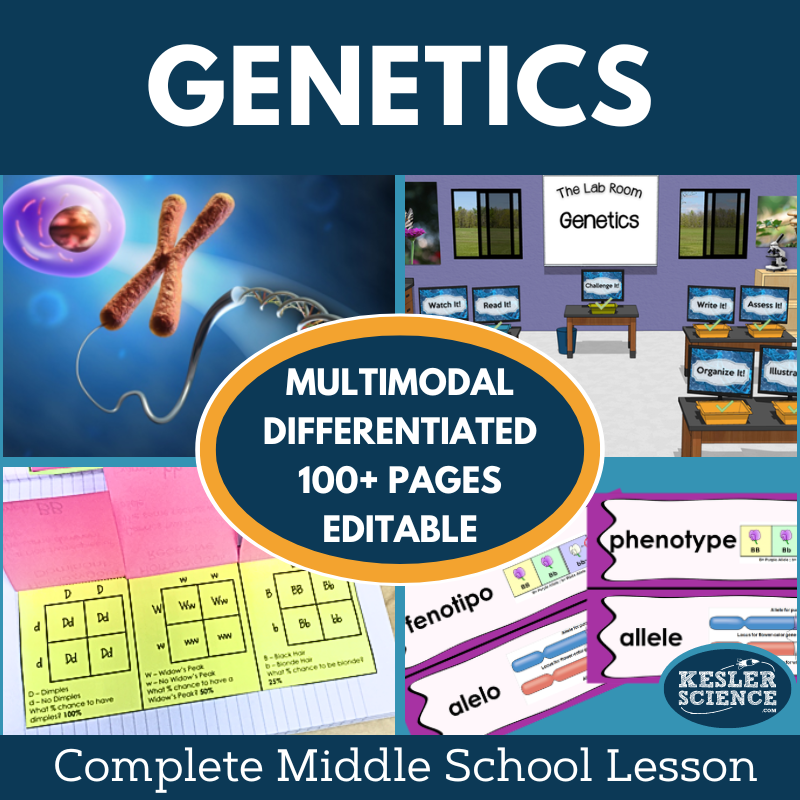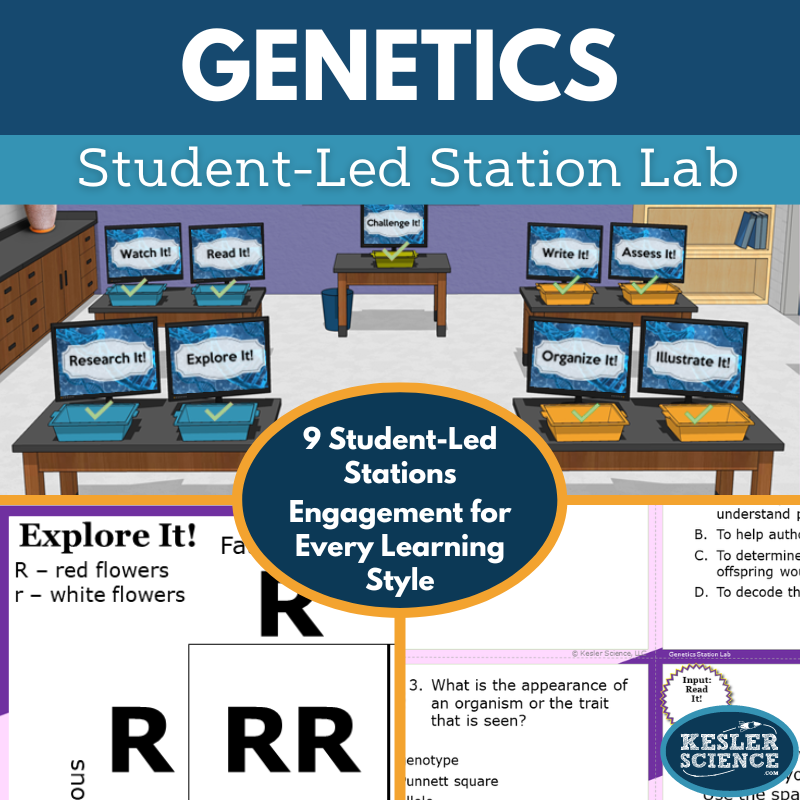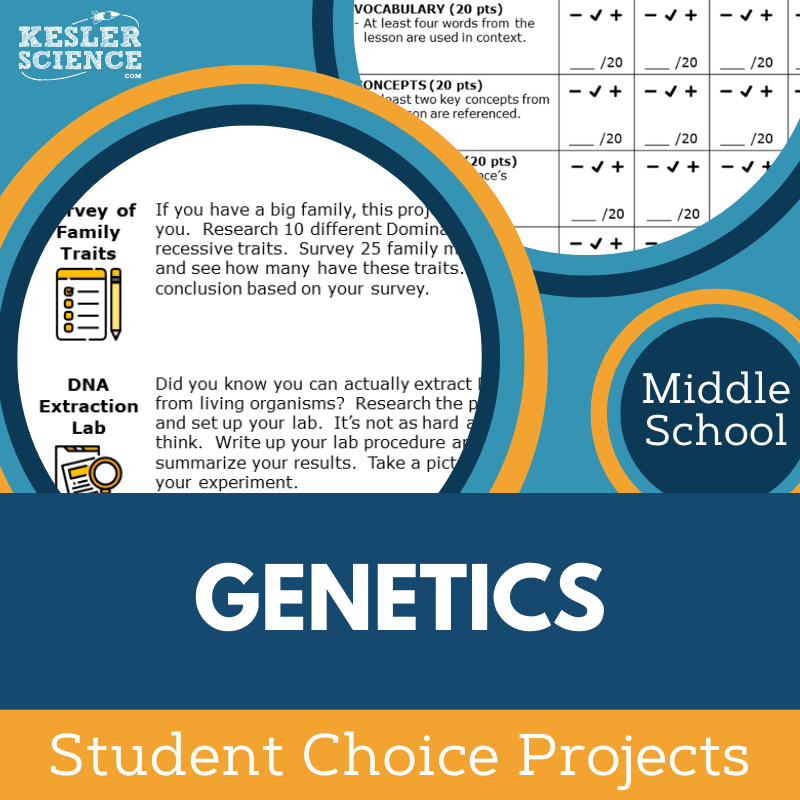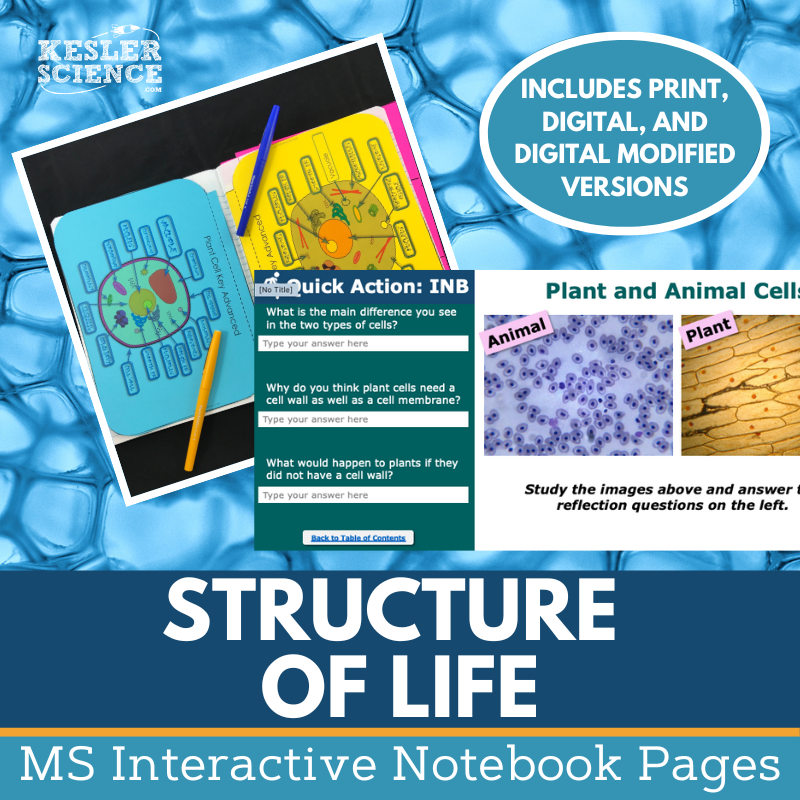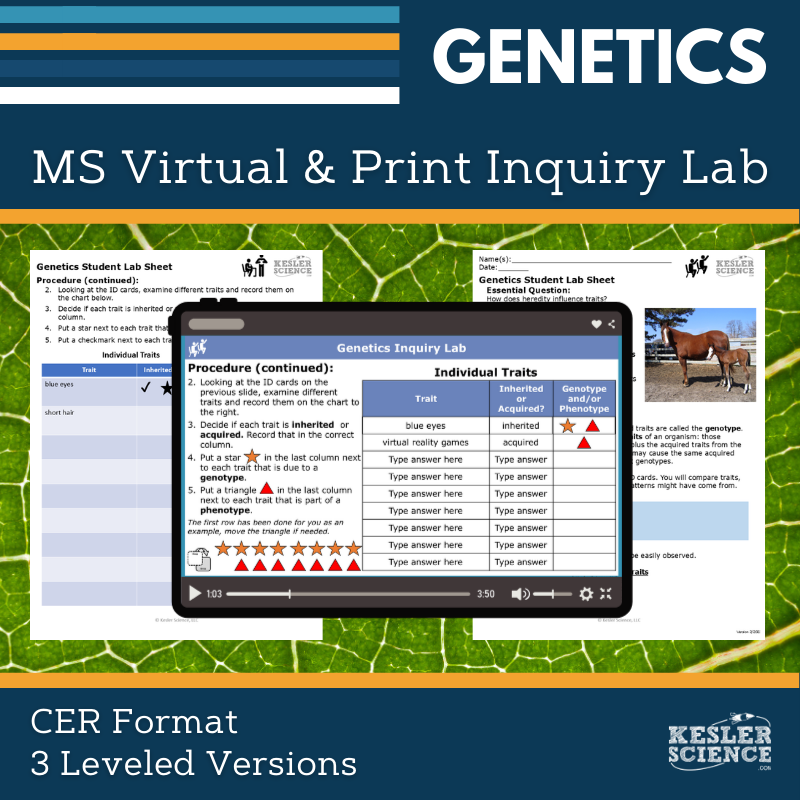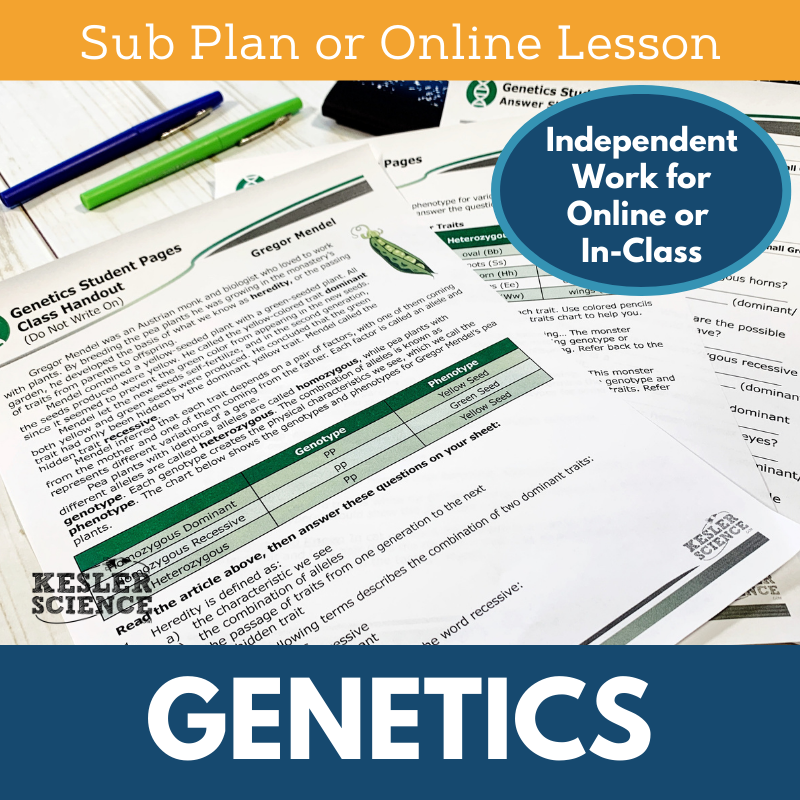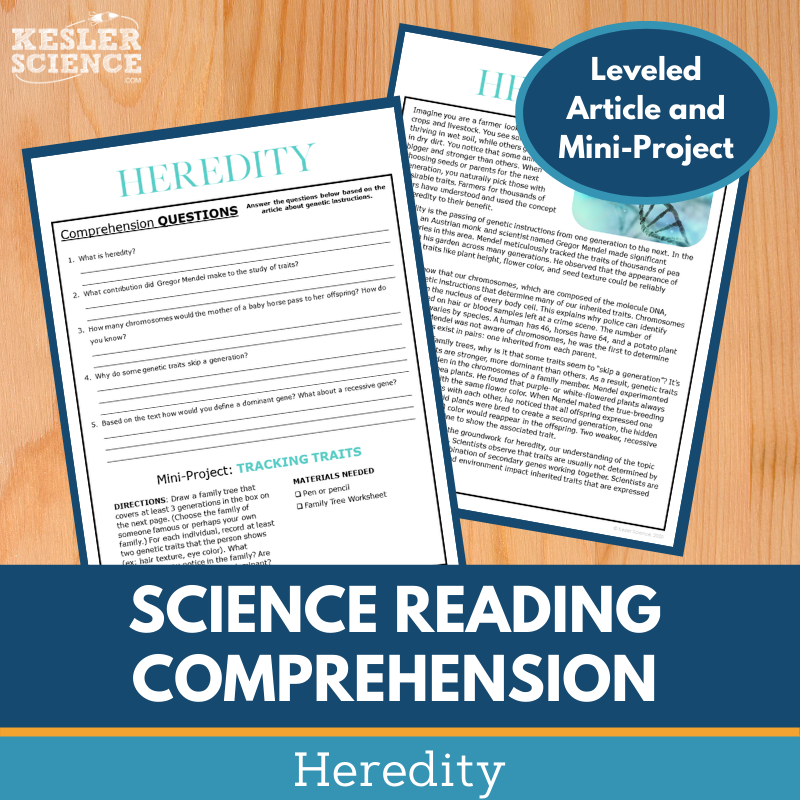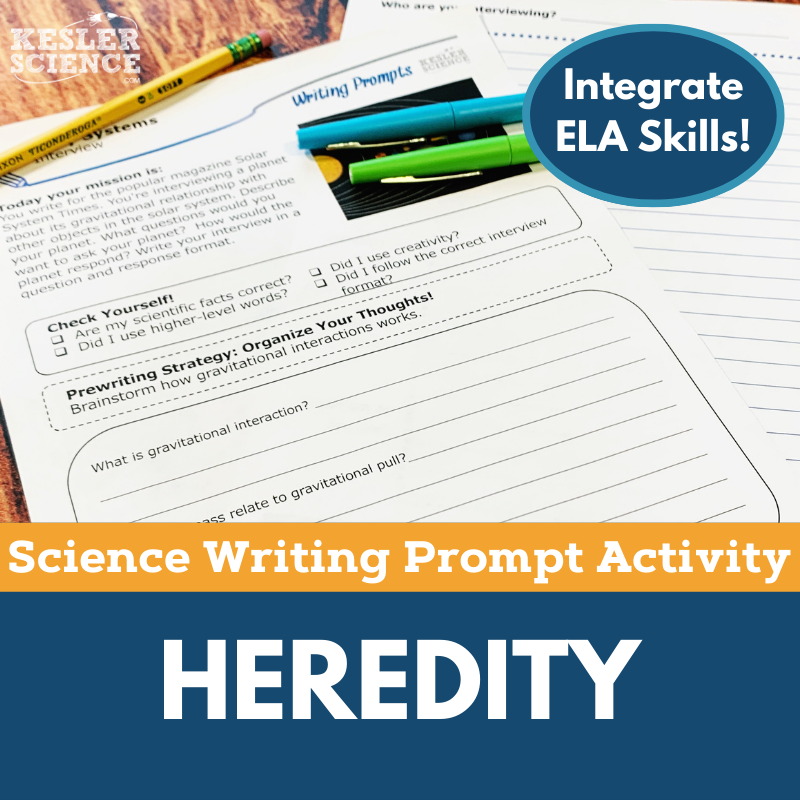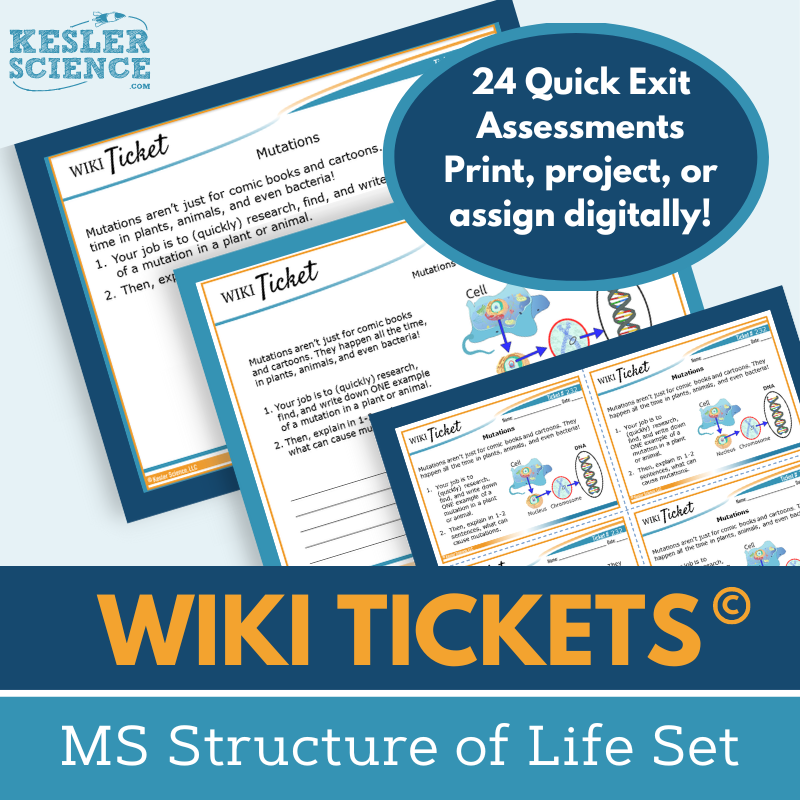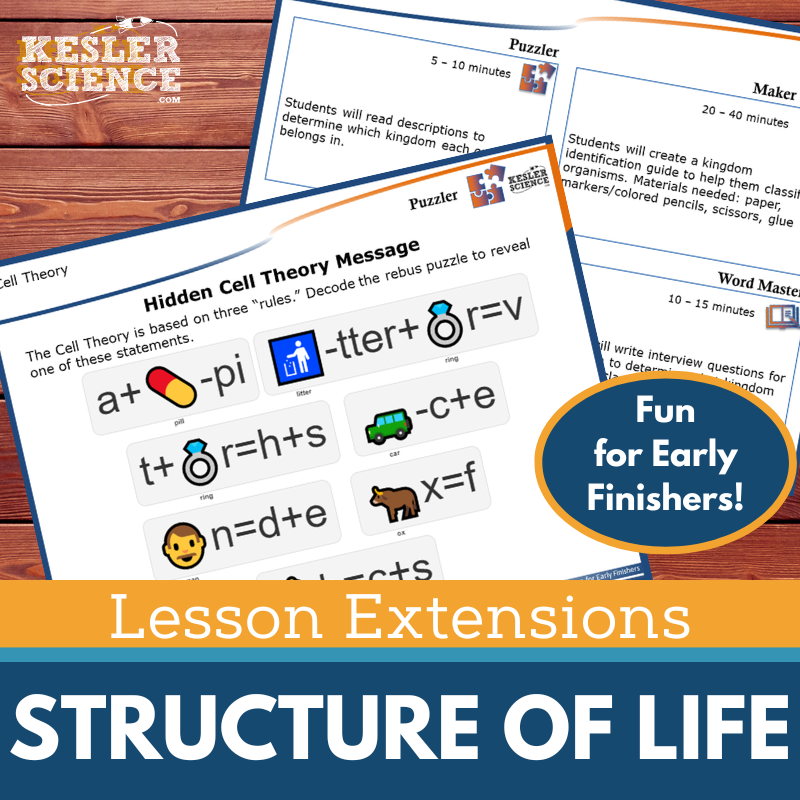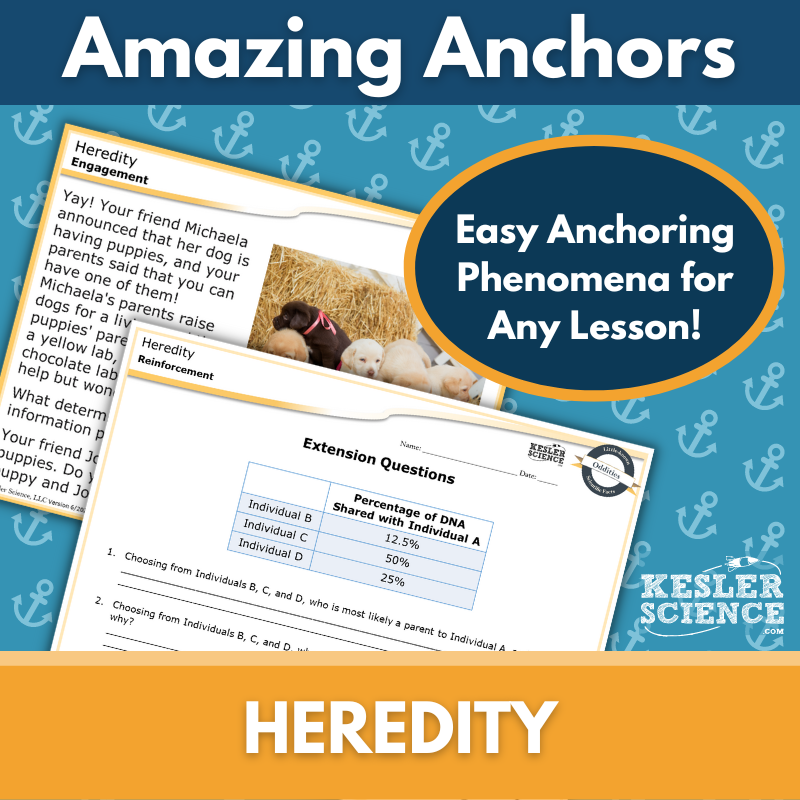Genetics Activities for Middle School Science
The Kesler Science Genetics resources provide middle school students with comprehensive materials to explore the fundamentals of genetic inheritance. The resources below will give students a comprehensive understanding of genetics. All of the following materials are also included in the Kesler Science Membership.
The Kesler Science Genetics 5E Lesson is a comprehensive, low-prep unit that helps middle school students explore fundamental genetics concepts, such as heredity and Punnett squares. Designed around the 5E instructional model, the lesson supports differentiated, student-led learning through editable presentations, interactive notebooks, worksheets, and assessments. Vocabulary resources and templates are available in English and Spanish, offering flexible, multimodal instruction for classrooms or virtual learning.
Students engage in a hands-on station lab featuring nine activities that promote both input and output learning. Input stations include reading passages, videos, online research, and hands-on demonstrations, while output stations encourage students to write, illustrate, organize, and assess their understanding. A Challenge It! station offers enrichment opportunities for early finishers. The unit also includes teacher-guided engagement activities and support for common misconceptions.
To deepen learning, students complete choice-based projects during the elaboration phase and demonstrate mastery through STAAR 2.0-aligned evaluation tools, including modified assessments, review questions, and worksheets. This lesson available in both print and digital formats to accommodate diverse classroom needs.
The Kesler Science Genetics 5E Lesson is a comprehensive, low-prep unit that helps middle school students explore fundamental genetics concepts, such as heredity and Punnett squares. Designed around the 5E instructional model, the lesson supports differentiated, student-led learning through editable presentations, interactive notebooks, worksheets, and assessments. Vocabulary resources and templates are available in English and Spanish, offering flexible, multimodal instruction for classrooms or virtual learning.
Students engage in a hands-on station lab featuring nine activities that promote both input and output learning. Input stations include reading passages, videos, online research, and hands-on demonstrations, while output stations encourage students to write, illustrate, organize, and assess their understanding. A Challenge It! station offers enrichment opportunities for early finishers. The unit also includes teacher-guided engagement activities and support for common misconceptions.
To deepen learning, students complete choice-based projects during the elaboration phase and demonstrate mastery through STAAR 2.0-aligned evaluation tools, including modified assessments, review questions, and worksheets. This lesson available in both print and digital formats to accommodate diverse classroom needs.
The Kesler Science Genetics Station Lab is a student-led, modular activity that guides middle school students through exploring genetics concepts. With eight differentiated stations and an additional challenge station for advanced learners, students take charge of their learning while the teacher provides guidance. This hands-on, engaging format encourages students to work independently or in small groups, catering to different learning styles.
The station lab includes a mix of input and output stations for a well-rounded learning experience. Input stations like "Explore It!" and "Watch It!" allow students to interact with new genetics concepts through hands-on demonstrations, videos, and research. Output stations such as "Organize It!" and "Assess It!" enable students to showcase their understanding by creating visual models and responding to task cards that assess their knowledge.
This resource is highly flexible, with differentiated activities designed to meet the needs of all learners. Available in both print and digital formats, it can be used for in-person or remote learning. The digital version allows students to complete activities and manipulate content through platforms like PowerPoint and Google Slides, ensuring an engaging experience in any learning environment.
The Kesler Science Genetics Station Lab is a student-led, modular activity that guides middle school students through exploring genetics concepts. With eight differentiated stations and an additional challenge station for advanced learners, students take charge of their learning while the teacher provides guidance. This hands-on, engaging format encourages students to work independently or in small groups, catering to different learning styles.
The station lab includes a mix of input and output stations for a well-rounded learning experience. Input stations like "Explore It!" and "Watch It!" allow students to interact with new genetics concepts through hands-on demonstrations, videos, and research. Output stations such as "Organize It!" and "Assess It!" enable students to showcase their understanding by creating visual models and responding to task cards that assess their knowledge.
This resource is highly flexible, with differentiated activities designed to meet the needs of all learners. Available in both print and digital formats, it can be used for in-person or remote learning. The digital version allows students to complete activities and manipulate content through platforms like PowerPoint and Google Slides, ensuring an engaging experience in any learning environment.
The Kesler Science Genetics Student Choice Projects offer middle school students a range of project options to demonstrate their understanding of genetics. With six different project choices and an option to "design your own," students can select a project that best suits their strengths and interests. The included grading rubric allows for flexible assessments by teachers, peers, or students themselves.
This resource is dynamic and can be modified to meet various learning needs. The projects come with a teacher directions page and editable rubrics that assess vocabulary, concepts, presentation, and clarity. Teachers can choose between two versions of the project page to support both remediation and challenge students.
The projects require common classroom supplies like paper, markers, and scissors, with some options available for digital completion. The lesson allows for creative expression and provides differentiated opportunities to meet the diverse needs of all students.
The Kesler Science Genetics Student Choice Projects offer middle school students a range of project options to demonstrate their understanding of genetics. With six different project choices and an option to "design your own," students can select a project that best suits their strengths and interests. The included grading rubric allows for flexible assessments by teachers, peers, or students themselves.
This resource is dynamic and can be modified to meet various learning needs. The projects come with a teacher directions page and editable rubrics that assess vocabulary, concepts, presentation, and clarity. Teachers can choose between two versions of the project page to support both remediation and challenge students.
The projects require common classroom supplies like paper, markers, and scissors, with some options available for digital completion. The lesson allows for creative expression and provides differentiated opportunities to meet the diverse needs of all students.
The Kesler Science Structure of Life Interactive Notebook Bundle provides an engaging way for students to explore life science concepts through interactive activities. Designed for both print and digital use, this resource is perfect for traditional classrooms, 1:1 environments, and distance learning. Topics covered include cell theory, genetics, plant and animal cells, and more, offering a comprehensive tool for teaching the structure of life.
The digital version includes a unique interactive notebook PowerPoint that can be uploaded to platforms like Google Slides or MS Teams, complete with reflection pages, note spaces, and an answer key. A modified digital version is also provided for students needing accommodations. The paper version features blank and pre-filled templates, along with color photos to guide usage, ensuring all students can participate effectively.
With resources tailored for diverse learning needs, the Kesler Science Structure of Life Interactive Notebook Bundle supports differentiated instruction and student-centered learning. Teachers gain a versatile tool for enhancing understanding, while students build lasting connections to key life science concepts.
The Kesler Science Structure of Life Interactive Notebook Bundle provides an engaging way for students to explore life science concepts through interactive activities. Designed for both print and digital use, this resource is perfect for traditional classrooms, 1:1 environments, and distance learning. Topics covered include cell theory, genetics, plant and animal cells, and more, offering a comprehensive tool for teaching the structure of life.
The digital version includes a unique interactive notebook PowerPoint that can be uploaded to platforms like Google Slides or MS Teams, complete with reflection pages, note spaces, and an answer key. A modified digital version is also provided for students needing accommodations. The paper version features blank and pre-filled templates, along with color photos to guide usage, ensuring all students can participate effectively.
With resources tailored for diverse learning needs, the Kesler Science Structure of Life Interactive Notebook Bundle supports differentiated instruction and student-centered learning. Teachers gain a versatile tool for enhancing understanding, while students build lasting connections to key life science concepts.
The Genetics Inquiry Lab aligns with NGSS standards and gives students the opportunity to explore how inherited traits are passed through generations. Students will examine trait data from provided ID cards, chart group results, and look for patterns to explain the role heredity plays in observable characteristics. Both digital and print formats are included, each with comprehension questions, C.E.R. prompts, and reflection sections to support learning.
Differentiated instruction is built in with three lab versions—Dependent, Modified, and Independent—designed to support a wide range of learners. The Dependent level offers guided procedures and inquiry questions, the Modified level includes extra supports like sentence stems and multiple choice, and the Independent version encourages student-led exploration with minimal guidance.
Digital labs require no physical materials and are fully interactive, while the print version uses simple supplies like pencils, paper, and printed ID cards. All files are editable, compatible with Google Slides, and come with teacher resources, answer keys, and clearly outlined standards and objectives, providing a flexible, engaging experience for any classroom.
The Genetics Inquiry Lab aligns with NGSS standards and gives students the opportunity to explore how inherited traits are passed through generations. Students will examine trait data from provided ID cards, chart group results, and look for patterns to explain the role heredity plays in observable characteristics. Both digital and print formats are included, each with comprehension questions, C.E.R. prompts, and reflection sections to support learning.
Differentiated instruction is built in with three lab versions—Dependent, Modified, and Independent—designed to support a wide range of learners. The Dependent level offers guided procedures and inquiry questions, the Modified level includes extra supports like sentence stems and multiple choice, and the Independent version encourages student-led exploration with minimal guidance.
Digital labs require no physical materials and are fully interactive, while the print version uses simple supplies like pencils, paper, and printed ID cards. All files are editable, compatible with Google Slides, and come with teacher resources, answer keys, and clearly outlined standards and objectives, providing a flexible, engaging experience for any classroom.
The Kesler Science Genetics Sub Plans guide students through a warm-up puzzle, reading passage, and independent activity, all while exploring DNA and genetic traits. Students analyze a table to understand homozygous dominant, heterozygous, and homozygous recessive traits and complete related questions. Early finishers can extend their learning by creating and illustrating "monster parents" and describing their genotypes and phenotypes.
The lesson includes detailed instructions for substitutes and is designed to keep students engaged, with activities, behavior checkpoints, and assessments. The comprehensive genetics lesson comes with a variety of handouts and assessments to accommodate multiple sections and class sizes. There are also options for distance learning with Google Form answer sheets and PDFs for online annotation.
These sub plans are flexible and easy to implement, whether in-person, remote, or for extended assignments. Teachers can use them for sub days, homework, extra credit, or small group instruction. The materials are student-centered, with clear directions and editable formats to suit different teaching needs.
The Kesler Science Genetics Sub Plans guide students through a warm-up puzzle, reading passage, and independent activity, all while exploring DNA and genetic traits. Students analyze a table to understand homozygous dominant, heterozygous, and homozygous recessive traits and complete related questions. Early finishers can extend their learning by creating and illustrating "monster parents" and describing their genotypes and phenotypes.
The lesson includes detailed instructions for substitutes and is designed to keep students engaged, with activities, behavior checkpoints, and assessments. The comprehensive genetics lesson comes with a variety of handouts and assessments to accommodate multiple sections and class sizes. There are also options for distance learning with Google Form answer sheets and PDFs for online annotation.
These sub plans are flexible and easy to implement, whether in-person, remote, or for extended assignments. Teachers can use them for sub days, homework, extra credit, or small group instruction. The materials are student-centered, with clear directions and editable formats to suit different teaching needs.
The heredity-themed Science Reading Comprehension Lesson helps middle school students explore how genetic instructions are passed from one generation to the next. After reading a leveled nonfiction article, students answer comprehension questions and complete a creative mini-project by building a family tree that tracks inherited traits across generations.
Designed for grades 6–8, the lesson includes two Lexile-leveled articles (1100–1300), five to seven comprehension questions, and an engaging, hands-on activity. A Cornell notes template supports structured learning, and the passage is ideal for building science literacy and textual analysis skills in a content-rich format.
The resource is fully compatible with virtual and in-person learning. Editable files can be uploaded to platforms like Google Classroom, Schoology, and Canvas. Perfect for sub plans, ISS, extra credit, or whole-class instruction, this lesson encourages discussion and reinforces key concepts in heredity through interactive reading and writing tasks.
The heredity-themed Science Reading Comprehension Lesson helps middle school students explore how genetic instructions are passed from one generation to the next. After reading a leveled nonfiction article, students answer comprehension questions and complete a creative mini-project by building a family tree that tracks inherited traits across generations.
Designed for grades 6–8, the lesson includes two Lexile-leveled articles (1100–1300), five to seven comprehension questions, and an engaging, hands-on activity. A Cornell notes template supports structured learning, and the passage is ideal for building science literacy and textual analysis skills in a content-rich format.
The resource is fully compatible with virtual and in-person learning. Editable files can be uploaded to platforms like Google Classroom, Schoology, and Canvas. Perfect for sub plans, ISS, extra credit, or whole-class instruction, this lesson encourages discussion and reinforces key concepts in heredity through interactive reading and writing tasks.
The Heredity Science Writing Activity invites middle school students to demonstrate their life science knowledge using an engaging interview-style question and answer format. Designed to enrich writing skills while reinforcing key heredity concepts, this low-prep activity works well in both print and digital formats, supporting in-person and virtual learning environments. Students apply science reasoning in a creative context, deepening their understanding through structured prompts.
This resource includes teacher directions, answer keys, and both full- and half-sheet rubrics. Students are provided with a writing prompt, pre-writing strategy, self-check tools, and layout templates in both color and black-and-white options. A digital version in PowerPoint (easily adaptable to Google Slides) allows for flexible use in any classroom setting. Materials are ideal for display, interactive notebooks, or digital submission.
Aligned to TEKS and NGSS standards, this student-centered activity can serve as a cross-curricular exercise, pre-test assessment, enrichment task, extra credit, or make-up work. It supports differentiation and works best when students have prior knowledge or access to research materials. The Heredity Science Writing Prompt makes a strong addition to any middle school life science curriculum.
The Heredity Science Writing Activity invites middle school students to demonstrate their life science knowledge using an engaging interview-style question and answer format. Designed to enrich writing skills while reinforcing key heredity concepts, this low-prep activity works well in both print and digital formats, supporting in-person and virtual learning environments. Students apply science reasoning in a creative context, deepening their understanding through structured prompts.
This resource includes teacher directions, answer keys, and both full- and half-sheet rubrics. Students are provided with a writing prompt, pre-writing strategy, self-check tools, and layout templates in both color and black-and-white options. A digital version in PowerPoint (easily adaptable to Google Slides) allows for flexible use in any classroom setting. Materials are ideal for display, interactive notebooks, or digital submission.
Aligned to TEKS and NGSS standards, this student-centered activity can serve as a cross-curricular exercise, pre-test assessment, enrichment task, extra credit, or make-up work. It supports differentiation and works best when students have prior knowledge or access to research materials. The Heredity Science Writing Prompt makes a strong addition to any middle school life science curriculum.
The Kesler Science WIKI Tickets are flexible, engaging formative assessments designed for middle school science topics. The Structure of Life Set includes 24 colorful assessments that can be used as exit tickets, bellringers, or quick checks for understanding. Each topic features five formats: a projection version, three print sizes, and an interactive digital version compatible with PowerPoint or Google Slides.
Aligned with NGSS and TEKS standards, these assessments cover key topics like asexual vs. sexual reproduction, cell functions, heredity, homeostasis, and turgor pressure. The included table of contents helps teachers easily identify alignment with specific standards, ensuring comprehensive coverage. With options for both in-class and virtual learning, these assessments offer maximum flexibility.
These "What I Know Is" assessments provide teachers with a clear picture of student understanding. Whether used in a traditional classroom or a remote setting, they are an easy, engaging way to track progress and identify learning gaps.
The Kesler Science WIKI Tickets are flexible, engaging formative assessments designed for middle school science topics. The Structure of Life Set includes 24 colorful assessments that can be used as exit tickets, bellringers, or quick checks for understanding. Each topic features five formats: a projection version, three print sizes, and an interactive digital version compatible with PowerPoint or Google Slides.
Aligned with NGSS and TEKS standards, these assessments cover key topics like asexual vs. sexual reproduction, cell functions, heredity, homeostasis, and turgor pressure. The included table of contents helps teachers easily identify alignment with specific standards, ensuring comprehensive coverage. With options for both in-class and virtual learning, these assessments offer maximum flexibility.
These "What I Know Is" assessments provide teachers with a clear picture of student understanding. Whether used in a traditional classroom or a remote setting, they are an easy, engaging way to track progress and identify learning gaps.
The Kesler Science Structure of Life Lesson Extensions provide student-choice activities designed to keep fast finishers engaged with critical thinking and creative tasks. These extensions are perfect for wrapping up lessons, filling time during testing, or offering advanced learners opportunities to deepen their understanding of life science concepts. Aligned with NGSS and TEKS standards, the extensions include activities such as puzzles, hands-on Maker Space projects, digital media tasks, and creative writing challenges.
Each Lesson Extension includes teacher directions, answer keys, and both projection and printable versions for maximum flexibility. With topics ranging from cell structure to heredity and natural selection, students can explore concepts through problem-solving, STEAM connections, and creative expression. These activities encourage deeper exploration of topics like artificial selection, genetic mutations, and environmental factors.
Kesler Science Lesson Extensions are ideal for scaffolding learning or challenging independent learners. By incorporating engaging activities like Puzzler, Maker Space, Tech Connection, and Word Master, these resources provide rigorous yet enjoyable options to enrich life science lessons.
The Kesler Science Structure of Life Lesson Extensions provide student-choice activities designed to keep fast finishers engaged with critical thinking and creative tasks. These extensions are perfect for wrapping up lessons, filling time during testing, or offering advanced learners opportunities to deepen their understanding of life science concepts. Aligned with NGSS and TEKS standards, the extensions include activities such as puzzles, hands-on Maker Space projects, digital media tasks, and creative writing challenges.
Each Lesson Extension includes teacher directions, answer keys, and both projection and printable versions for maximum flexibility. With topics ranging from cell structure to heredity and natural selection, students can explore concepts through problem-solving, STEAM connections, and creative expression. These activities encourage deeper exploration of topics like artificial selection, genetic mutations, and environmental factors.
Kesler Science Lesson Extensions are ideal for scaffolding learning or challenging independent learners. By incorporating engaging activities like Puzzler, Maker Space, Tech Connection, and Word Master, these resources provide rigorous yet enjoyable options to enrich life science lessons.
This Amazing Anchors Phenomenon Lesson introduces and reinforces the concept of heredity through real-world connections. Students begin with an engaging reading about a litter of puppies, followed by comprehension and extension questions to activate prior knowledge. A second reading clearly explains the science behind heredity, helping students build a deeper understanding through additional questions and reinforcement activities.
Aligned with TEKS, this no-prep resource includes teacher directions, answer keys, editable projection slides, and both print and digital formats for use with interactive notebooks or digital platforms. Full- and half-sheet versions offer flexibility for classroom or virtual instruction. A modified version supports differentiated learning with simplified language and sentence starters to assist students.
Designed to support the Engagement and Elaborate phases of the 5E Model, these before-and-after readings provide meaningful bookends to any heredity lesson. Whether used as an introduction or review, this resource enhances student understanding by connecting science content to familiar, real-world examples.
This Amazing Anchors Phenomenon Lesson introduces and reinforces the concept of heredity through real-world connections. Students begin with an engaging reading about a litter of puppies, followed by comprehension and extension questions to activate prior knowledge. A second reading clearly explains the science behind heredity, helping students build a deeper understanding through additional questions and reinforcement activities.
Aligned with TEKS, this no-prep resource includes teacher directions, answer keys, editable projection slides, and both print and digital formats for use with interactive notebooks or digital platforms. Full- and half-sheet versions offer flexibility for classroom or virtual instruction. A modified version supports differentiated learning with simplified language and sentence starters to assist students.
Designed to support the Engagement and Elaborate phases of the 5E Model, these before-and-after readings provide meaningful bookends to any heredity lesson. Whether used as an introduction or review, this resource enhances student understanding by connecting science content to familiar, real-world examples.
Year-Round Resources
These year-round activities will increase your students' understanding of many middle school science topics. All of these activities are also included in the Kesler Science Membership.
Visual Data & Graphing
You're not alone if your students struggle with understanding graphs, charts, and tables. It's a skill that takes an enormous amount of practice. This resource will help students build a strong foundation in analyzing data and creating their own data visualizations.
Bell Ringers and Warm-Ups
These middle school science bell ringers are an excellent way to engage your students as soon as they walk into your classroom. This comprehensive FULL YEAR resource includes everything you need to start off each science class with an interesting warm-up activity.
Review Board Games
Each game board has been carefully designed to keep students engaged. There are 10 different action spaces on each board and dozens of question cards. All of the actions are related to science concepts and keep the students motivated throughout the game.
Each game is ready to play. Simply print out the board and the cards and let the students enjoy reviewing nine different units.
Essential Questions
Below are the essential questions associated with the lessons and activities included in this unit. This topic is only one of more than 100 middle school science topics included in the Kesler Science Membership.
-
What is genetics?
-
How are Punnett squares used to describe the genetic relationship between parent to offspring?
Kesler Science Membership
Imagine never having to search for another middle school science lesson again. The membership gives you access to ALL of the Kesler Science products in one place (Yes, including everything above).
Say goodbye to long hours of lesson prep.

